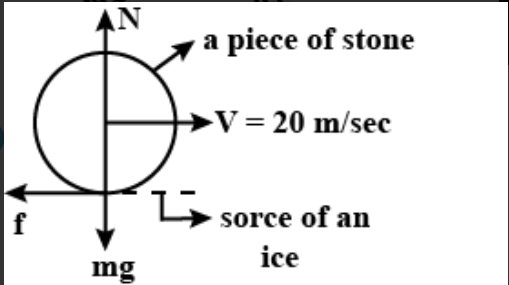Answer
64.8k+ views
Hint: We should know that velocity is defined as the rate change of displacement per unit time. Speed in a specific direction is also known as velocity. Velocity is equal to displacement divided by time. Speed, being a scalar quantity, is the rate at which an object covers distance. The average speed is the distance which is a scalar quantity per time ratio. On the other hand, velocity is a vector quantity; it is direction-aware. An object which moves in the negative direction has a negative velocity. If the object is slowing down then its acceleration vector is directed in the opposite direction as its motion in this case. Based on this we have to solve this question.
Complete step by step answer
Before we proceed, we have to make a free body diagram of the stone-ice system. In the figure, we are seeing that frictional force acting in leftward while the stone is moving rightward direction. One thing we have to fix in our mind that frictional force will always act opposite to the direction of motion of the body. Now on resolving the forces, $\mathrm{f}-\mathrm{ma} = 0$ or $\mathrm{f}=\mathrm{ma}$ also form the equation of motion $\mathrm{v}^{2}=\mathrm{u}^{2}+2as$ as, here final velocity is zero, so $\mathrm{v}=0$

$\mathrm{u}^{2}=-2 \mathrm{as}$
$\mathrm{u}^{2}=-2 \mathrm{as}$
$\mathrm{a}=\dfrac{-\mathrm{u}^{2}}{2 \mathrm{s}}=-\dfrac{20^{2}}{2 \times 50}=-4 \dfrac{\mathrm{m}}{\mathrm{sec}^{2}}$
On substituting the given data in equation (1) $\mathrm{f}=1 \times(-4)=-4 \mathrm{N}$
Note: We should know that if an object's speed or velocity is increasing at a constant rate then we say it has uniform acceleration. The rate of acceleration is constant. If a car speeds up then slows down then speeds up it doesn't have uniform acceleration. The instantaneous acceleration, or simply acceleration, is defined as the limit of the average acceleration when the interval of time considered approaches 0. It is also defined in a similar manner as the derivative of velocity with respect to time. If an object begins acceleration from rest or a standstill, its initial time is 0. If we get a negative value for acceleration, it means the object is slowing down. The acceleration of an object is its change in velocity over an increment of time. This can mean a change in the object's speed or direction. Average acceleration is the change of velocity over a period of time. Constant or uniform acceleration is when the velocity changes the same amount in every equal time period.
Complete step by step answer
Before we proceed, we have to make a free body diagram of the stone-ice system. In the figure, we are seeing that frictional force acting in leftward while the stone is moving rightward direction. One thing we have to fix in our mind that frictional force will always act opposite to the direction of motion of the body. Now on resolving the forces, $\mathrm{f}-\mathrm{ma} = 0$ or $\mathrm{f}=\mathrm{ma}$ also form the equation of motion $\mathrm{v}^{2}=\mathrm{u}^{2}+2as$ as, here final velocity is zero, so $\mathrm{v}=0$

$\mathrm{u}^{2}=-2 \mathrm{as}$
$\mathrm{u}^{2}=-2 \mathrm{as}$
$\mathrm{a}=\dfrac{-\mathrm{u}^{2}}{2 \mathrm{s}}=-\dfrac{20^{2}}{2 \times 50}=-4 \dfrac{\mathrm{m}}{\mathrm{sec}^{2}}$
On substituting the given data in equation (1) $\mathrm{f}=1 \times(-4)=-4 \mathrm{N}$
Note: We should know that if an object's speed or velocity is increasing at a constant rate then we say it has uniform acceleration. The rate of acceleration is constant. If a car speeds up then slows down then speeds up it doesn't have uniform acceleration. The instantaneous acceleration, or simply acceleration, is defined as the limit of the average acceleration when the interval of time considered approaches 0. It is also defined in a similar manner as the derivative of velocity with respect to time. If an object begins acceleration from rest or a standstill, its initial time is 0. If we get a negative value for acceleration, it means the object is slowing down. The acceleration of an object is its change in velocity over an increment of time. This can mean a change in the object's speed or direction. Average acceleration is the change of velocity over a period of time. Constant or uniform acceleration is when the velocity changes the same amount in every equal time period.
Recently Updated Pages
Write a composition in approximately 450 500 words class 10 english JEE_Main

Arrange the sentences P Q R between S1 and S5 such class 10 english JEE_Main

What is the common property of the oxides CONO and class 10 chemistry JEE_Main

What happens when dilute hydrochloric acid is added class 10 chemistry JEE_Main

If four points A63B 35C4 2 and Dx3x are given in such class 10 maths JEE_Main

The area of square inscribed in a circle of diameter class 10 maths JEE_Main

Other Pages
Excluding stoppages the speed of a bus is 54 kmph and class 11 maths JEE_Main

In the ground state an element has 13 electrons in class 11 chemistry JEE_Main

Electric field due to uniformly charged sphere class 12 physics JEE_Main

A boat takes 2 hours to go 8 km and come back to a class 11 physics JEE_Main

According to classical free electron theory A There class 11 physics JEE_Main

Differentiate between homogeneous and heterogeneous class 12 chemistry JEE_Main



